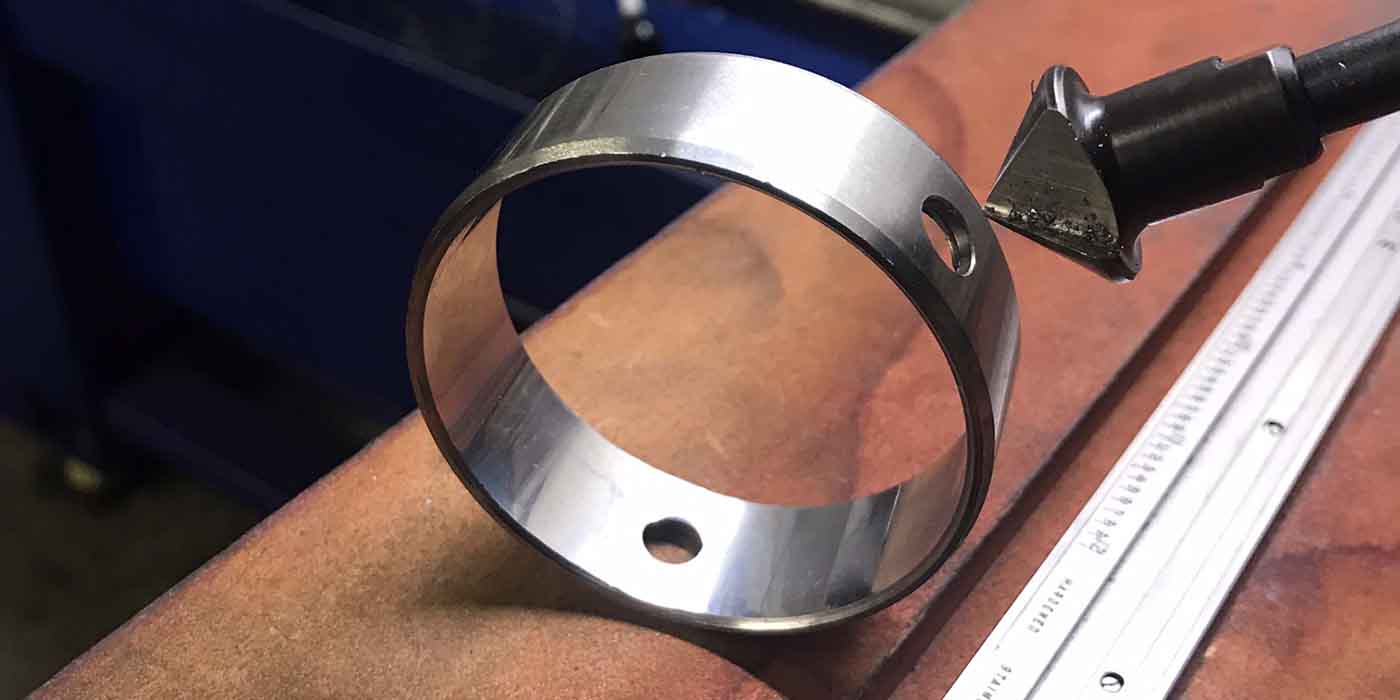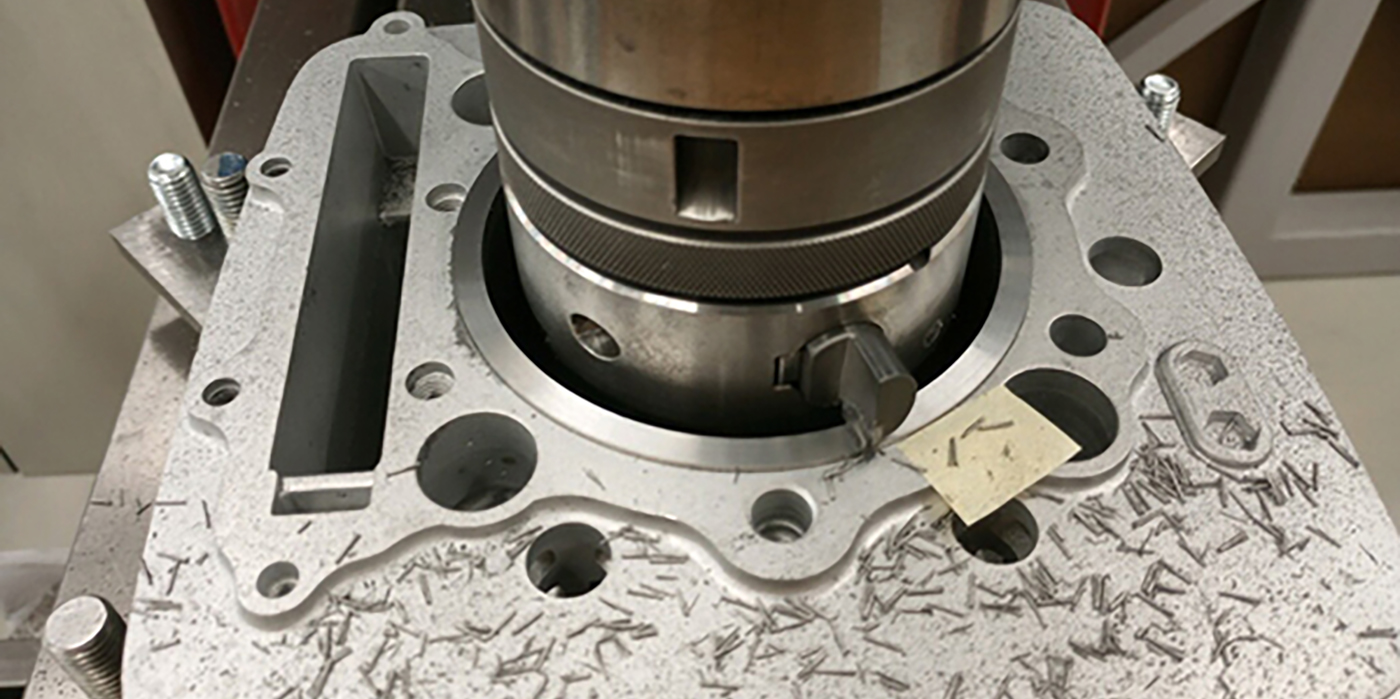Removing Stubborn Dowel Pins
Do you ever have solid dowel pins that are worn or tapered, and the slap hammer slips off no matter how tight you make it? Add a dab of valve lapping compound to the dowel pin. It works wonders. Most of the time the pin slaps right out.
Jeffrey Myers
MAR Automotive, Inc.
Philadelphia, PA
Making Your Own Valve Seal Removal Tool
In older vehicles, valve seals often stick and are hard to remove. Tool manufacturers make handy tools to remove the seals, but they can be costly.
Here is how to make your own valve seal removal tool. Start with a pair of new or used vise grips, take an old socket or some tubing stock and cut it down the middle. Weld the halves to the jaw of the vise grips. You now have an inexpensive valve stem seal removal tool.
Roy Maloney
Engine & Performance Warehouse
Houston, TX
Lighting Up Your Shop
Proper lighting in a machine shop can make a big difference in the quality of your work, and also make a positive impression on customers. We have all ventured into “black holes” of machine shops and wondered how anybody can turn out good quality work in a place like that. Replacing old lighting fixtures with new, more efficient fixtures is one way to increase light and reduce your electric bill.
Probably the easiest way to make your shop brighter and well lit is to paint the walls and ceiling white. Painting the floor a practical color, like grey, and keeping it clean is another way to keep things light and make a positive impression with your customers.
Something you may have already thought of – don’t paint the bottom few feet of your shop walls white. That is probably taking light and white too far.
Steve Rich
Sterling Bearing, Inc.
Kansas City, MO
 Measuring Camshaft Thrust Button Clearance in Chevy V8 Engines
Measuring Camshaft Thrust Button Clearance in Chevy V8 Engines
If you need to measure proper clearance for your small block or big block Chevrolet V8 camshaft thrust button, modeling clay works very well. Here is what you need to do:
• Install the gasket and chain assembly onto the engine without the thrust button;
• Then, take a wad of soft modeling clay and put it into the hole where the thrust button will go;
• Next, install the cover and then remove it. This squishes the clay into shape;
• Now, carefully remove the clay and measure the thickness. Some light oil on the surface will keep it from sticking to the metal;
• Finally, select the proper length thrust button or machine it to the proper length and proceed with the installation.
Jeff "Beezer" Beseth
BeezerBuilt
Newtown Square, PA
Yet Another Way To Remove Bushings
If you run into a situation where you have to remove a bushing from a blind hole and a pilot bearing puller will not work, here is another way to get the job done.
Take a standard threading tap that is close to the I.D. of the bushing and thread the bushing. You can then use a slide hammer or other type of puller to remove the bushing, or you can thread it all the way in and then jack the bushing out with a bolt.
Lee Johnson
Pro Performance
Denver, CO
Editor’s Note: In our March 2013 issue we ran a Shop Solution titled "Which Piston Rings to Use 7.3L Ford V8 Diesels." Below is a reader’s response to the Shop Solution followed by comments from the author.
On the 7.3L engines listed in the article, why would you use a Hastings manufactured ring? Sealed Power designed and dyno-tested these ring packs for IH years back and came up with new specs for people to follow. So if you really want to seal your 7.3L, do your homework. What would you set your gap on your #2 ring? Want to do this again soon?
Dennis Decker
via email
Re: Nice to see people are paying attention to details….
Second rings gaps are important. Research done starting in the ’90s found that many engines could benefit from increasing the gap on the second ring. This change reduces combustion gas pressure pulses between the top and second ring that can cause the top ring to lose its seal against the piston ring groove. The benefits of these wider gaps, within reason, are improved power, better oil control and reduced emissions.
Hastings Manufacturing has long been on top of these revised larger second ring gaps. Here are the second ring gaps that have been designed into the Hastings ring sets for the Ford 7.3L engines based on OE recommendations and our own piston ring testing and development:
• 1988-’94 Ford 7.3L IDI Naturally Aspirated (Rectangular 2nd rings) Second ring gap .062? – .072? (Set #2M4741);
• 1993-’94 Ford 7.3L IDI Factory Turbo (Keystone 2nd rings) Second ring gap .055? – .065? (Set #2M4873); and
• 1994.5-2003 Ford 7.3L DI Power Stroke (Rectangular 2nd rings) Second ring gap .062? – .072? (Set #2M4882).
You can be assured that Hastings Manufacturing Company supplies piston rings that are top quality. Hastings is TS-16949 and ISO14001 registered and has a long history as an original equipment supplier to Ford, General Motors, Chrysler, Harley-Davidson and many other
engine manufacturers.
Response from
Ray Falkenrath,
Director of Product Development,
Hastings Mfg. Co.
Factoid of the Month: Which vehicles are the most American made?
It is a common belief that many Toyota and Honda vehicles are more American made than our “Big Three” vehicles.
Not so, according to Prof. Frank DuBois of the Kogod School of Business at American University. His recent study viewed 253 cars, trucks and SUVs to determine which had the most domestic content. The study takes into account labor, R&D, inventory, capital spent, engine parts, transmission parts, body, interior, chassis, electrical and profits.
Here are the most American made cars, according to the study:
Buick Enclave, Chevy Traverse, GMC Acadia 88.5
Ford F-Series trucks, Dodge Avenger 87.5
Chevy Corvette, Ford Mustang 85.0
Toyota Avalon (highest ranked import) 81.0
Engine Builder Shop Solutions is sponsored by Engine Pro,
a group of 9 engine parts specialist WDs in the U.S., and one in Australia, operating 35 branch
locations serving engine builders/rebuilders across the U.S and Australia. Authors of Shop
Solutions published in each issue of Engine Builder Magazine are awarded a prepaid $100 Visa gift card. Entries will be chosen by
the staff of Engine Builder Magazine and the Engine Pro Technical
Committee.
To submit a Shop Solution simply mail your entry
to Engine Builder Magazine, Shop Solutions, 3550 Embassy Parkway,
Akron, OH 44333; or email to Shop [email protected]. Shop
Solutions may also be emailed to [email protected].
You must include
your name, shop name, shop address and shop telephone number. Submitted
Shop Solutions not published will be kept on file and reevaluated for
publication with each month’s new entries. If you include your email
address you will be emailed notification of publication if your Shop
Solution is chosen.













